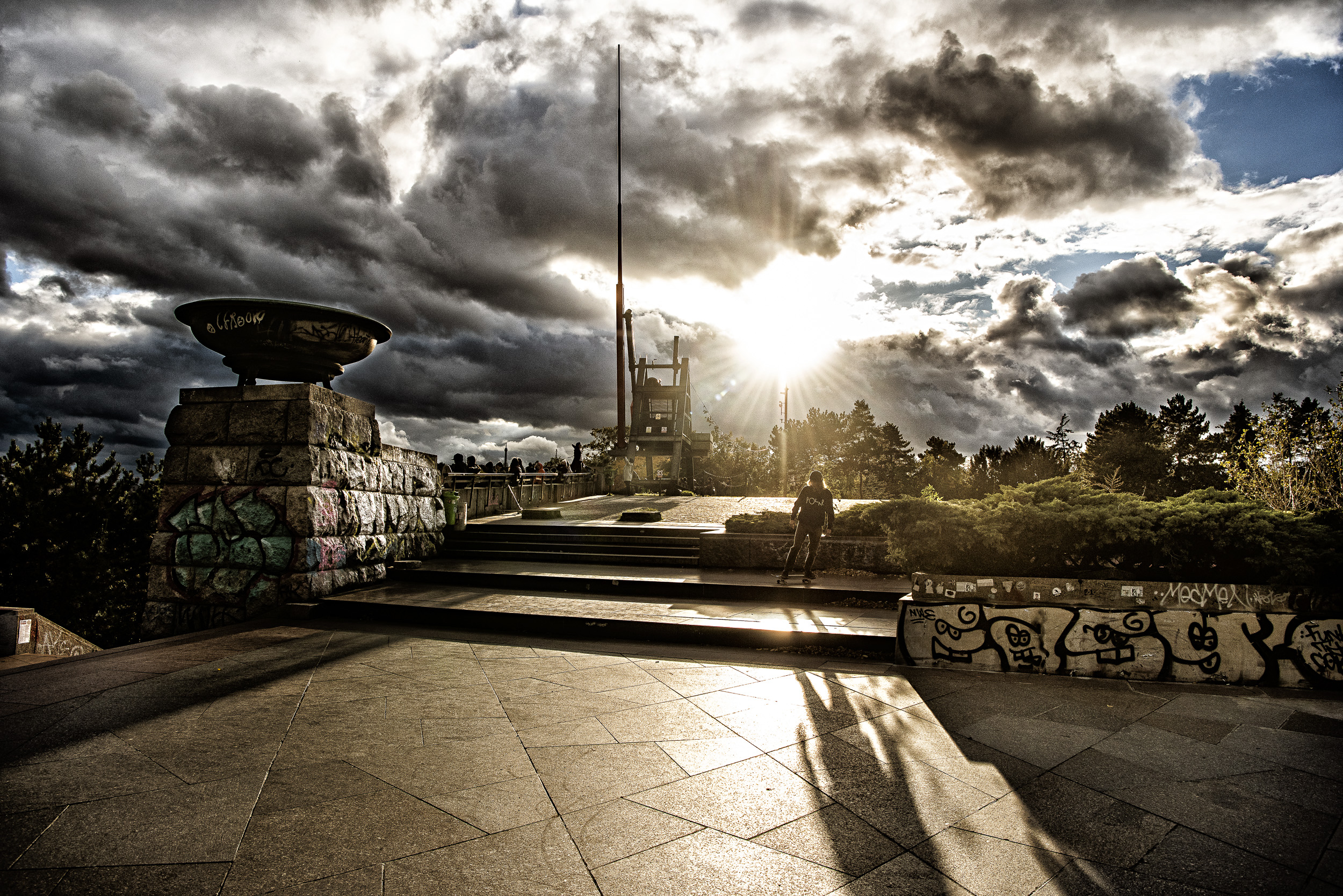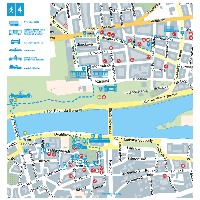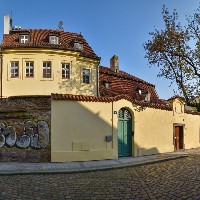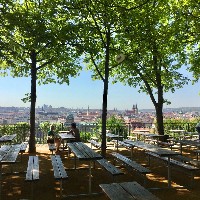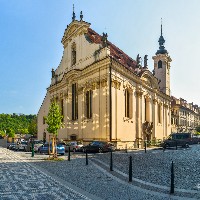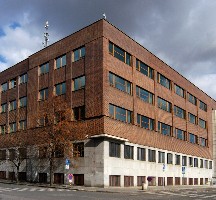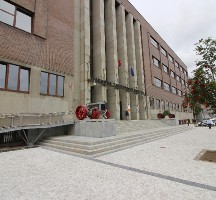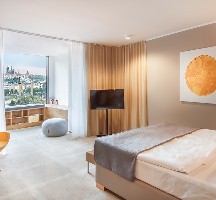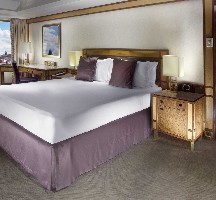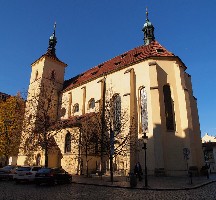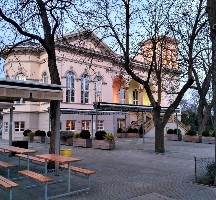Breadcrumbs navigation
From Letná to Old Town: Head Back in Time to a Hidden Garden
The walk creates both a literal and imaginary bridge between two worlds that, while different, still have much in common. It connects two very different Prague districts and two iconic buildings of Prague’s National Gallery: the Functionalist Trade Fair Palace (Veletržní palác), with the modern art collection, and the ancient Convent of St. Agnes of Bohemia, in which the medieval art collection is displayed. From Holešovice, your route takes you through Letná Park to the Metronome, a modern dominant of the left bank of the Vltava and across the bridge to the northernmost end of Old Town. Wind your way through the tiny lanes of this part of the city, which most visitors haven’t discovered yet and which will envelop you in the authentic atmosphere of old Prague. Your destination is the Convent of St Agnes and its recently renovated gardens.
- Sports & Relaxation
- walking routes
- TIP
Practical information
ROUTE DESCRIPTION
Route Length: 4 km / 2 miles
Trade Fair Palace / Veletržní palác (MHD tram stop) →
1. Trade Fair Palace (Veletržní palác) – National Gallery in Prague
The first Functionalist building in Prague, originally intended for trade fairs, was built in 1928 and was at the time the largest building of its type in the world – even Le Corbusier was an admirer. Today it’s home to the National Gallery’s unique collection of modern and contemporary art. The collection contains works by some of the most illustrious names in art – Pablo Picasso, Auguste Renoir, Vincent van Gogh, and Gustav Klimt among others. The gallery’s monumental interior, reminiscent of multiple decks of an ocean liner, is itself worth a look.
→ Heřmanova St. → Františka Křižíka St. →
2. Bio Oko
A popular single-screen art cinema that dates back to 1940. The cinema’s main floor is occupied with a motley crew of seats: sun loungers, beanbags, an auto body, and more, the composition of which was created by renowned Czech designer Maxim Velčovský. The bar and café are popular meeting spots.
→ Milady Horákové St. →
3. Letná Square (Letenské náměstí)
Worth noting along the right side of the square is the Neo-Renaissance Letná Water Tower, which is now used by the local children and youth centre for its activities. Also notable is the luxury (in its time) Functionalist reinforced concrete apartment block, nicknamed Molochov (built from 1936–1938). On the left side, note the imposing Constructivist Ministry of the Interior building with its tiled façade (built 1935–1939).
→ Nad Štolou St. → Letohradská St. → Muzejní St. →
4. National Technical Museum (Národní technické muzeum) and the National Museum of Agriculture (Národní zemědělské muzeum)
These identical monumental Functionalist structures were built together between 1938 and 1942. The original concept called for a single monumental building, but it ran up against construction regulations and, in particular, gradually progressing disagreements between the two institutions. In the end, two separate buildings were built, separated by Muzejni Street. The main entrances of both institutions face Letná Park - from this view, the buildings’ identical appearances are apparent.
→ Kostelní St. →
5. Letenský zámeček (Letná Mansion) built in the style of Italian Renaissance villas, now functions as a restaurant. From 1891 to 1916, the upper station of the Letná funicular, which ran here from the river, stood not far from here. Connected to the funicular was the station for the first electric tram in Prague, which was built on the occasion of the Provincial Jubilee Exhibition in 1891 by Czech inventor and pioneer of electrification, František Křižík; he then operated it as a private entrepreneur until 1900. Today in front of the chateau, you’ll find a very popular beer garden with an incredible view of the city centre and the Vltava River.
→ Letenské sady/Gardens →
6. The Metronome occupies a symbolic spot on the map of Prague. It was directly on this spot that a gigantic monument to Joseph Stalin overlooked the city. It was dynamited in 1962, many years after his death. The Metronome (official name: The Time Machine, by Vratislav Novák) appeared on Letná in 1991 and symbolises the impermanence of power and the inexorable progression of time. Today, the entire area around the Metronome is a haven for skateboarders.
→ down to nábřeží E. Beneše Riverbank → Svatopluk Čechův most/Bridge → Dvořákovo nábřeží/Riverbank
7. Intercontinental and President Hotels
Both hotels are examples of the local variety of Brutalist architecture. The Intercontinental’s Presidential Suite, measuring 154 sqm, with a panoramic view and its own sauna, used to be by far the most luxurious place to stay in Prague.
→ Dušní St. → 8 Church of Sts. Simon and Jude → 9 U Milosrdných St.
8. The Church of Sts. Simon and Jude (Kostel sv. Šimona a Judy) is proud of its rich musical tradition, including visits by Wolfgang Amadeus Mozart and Josef Haydn. The church has remained true to its musical roots and is today used as a concert venue.
9. U Milosrdných St. leads around the oldest wing of the hospital and monastery of the Brothers of Charity, who have run the hospital since 1620. In 1847, the first operation performed under anesthesia in the entire Austro-Hungarian Empire took place here.
Another building on the riverfront is the Na Františku city hospital. It was founded here around 1360 and has been in continuous operation since that time. It’s one of the oldest medical facilities in central Europe.
→ Kozí St. → “Kozí plácek” (“Goat Green”) → 10 U Obecního dvora St. → 11 Ve Stínadlech Lane
10. U Obecního dvora St.
Over the course of its existence, the Obecní dvůr (Municipal Yard) has served a number of functions, primarily business-related. The first recorded use was to stable horses and carriages, and later served as a royal firehouse. The House of the Censors (No. 798/5) was the actual location of the censors’ offices in the 19th century. House no. 799/7 was occupied by the famous dynasty of Czech painters, the Mánes family.
Curiosity: This entire area was a neighbourhood of the poorest Praguers, full of narrow streets with crooked houses and appalling sanitary conditions. Most of this district was demolished during the urban redevelopment that took place in the late 19th century.
11. Ve Stínadlech Lane
On the right, directly across from the Municipal Yard, walk through Ve Stínadlech Lane. Its modern name refers to the title of a novel by Jaroslav Foglar, popular Czech author of children’s adventure books, who set many of his stories in this neighbourhood of mysterious old houses and shadowy nooks.
→ Haštalské náměstí/Square → 12 Church of St. Castulus → 13 school and rectory → 14 ossuary → 15 old hospital
12. The Church of St. Castulus (Kostel sv. Haštala), founded in the late 12th century, is the only church dedicated to this saint in the country.
13. School and rectory
Since its founding, it also had a school and a rectory with a garden, surrounded by massive walls – today the building is used by various religious groups and organizations.
14. Ossuary
There used to be a cemetery around the church, its presence marked by a cross in the mosaic pavement; even today the former ossuary with a painted tombstone on the wall still stands.
15. Old hospital
At the corner of Řásnovka Street stands an unusual rounded corner building – the former hospital of the Knights of the Cross with the Red Star, the only originally Bohemian order and the only men’s order founded by a woman, princess Agnes of Bohemia. The original building was demolished in 1965 and replaced with a new building that stands on the original hospital foundations and copies its ground plan.
→ Řásnovka St. →
16. Řásnovka St. was originally named Schneck Street, after the manufacturer of popular playing cards. As the word Schneck is German for snail, irreverent Praguers kept referring to this street using various words for snails and slugs, until officials intervened and gave it its final official name, after the lord of Řásnov, owner of one of the buildings. In the olden days, the lane was also called At the Kings of the Cesspits, referring to the modest dwellings of poor labourers, knackers (those authorized to remove and dispose of carcasses), and even executioners who lived here.
→ Klášterská St. →
17. Ministry of Industry and Trade
The impressive ministry building, by architect Josef Fanta, was finished in 1934 with a record-high budget. It’s no wonder: the building, whose style was already anachronistic when it was built, features over 120 sculptures on its façade, plus a large number of other decorative elements.
The most characteristic feature of this magnificent building is the glass dome on the roof. It’s especially beautiful after dark – it remains illuminated all night.
Point of Interest: One of Josef Fanta’s other memorable designs was for the entrance hall and beautiful Art Nouveau café at Prague’s Main Train Station, formerly known as Wilson Station.
→ Na Františku St. → 18 Garden Behind the Churches (Zahrada za svatyněmi) → 19 North Gate Garden (Zahrada při severní bráně) → 20 Convent of St Agnes of Bohemia (Klášter sv. Anežky České)
18. Garden Behind the Churches (Zahrada za svatyněmi)
The convent gardens underwent an extensive renovation in 2016. The Garden Behind the Churches is now accessible via two new garden gates, and 19. the North Gate Garden (Zahrada při severní bráně) through a large Baroque gate from the riverbank side. The formerly inaccessible gardens are now home to two dozen works of contemporary sculpture by leading Czech artists.
20. Convent of St Agnes of Bohemia (Klášter sv. Anežky České)
The convent, one of the oldest and most important Gothic buildings in Prague, bears the name of its founder, Přemyslid princess St Agnes (1211–1282). During her lifetime, she built an extensive and artistically richly decorated convent with a royal burial ground, her own tomb, and several churches. When the convent was closed in 1782, it was already under threat of demolition because of its severely dilapidated condition. Thankfully this never took place. On the contrary – it was declared a national cultural monument and underwent gradual renovation throughout the 20th century. Today it houses the National Gallery’s collection of medieval art (highly recommended – this unique exhibition is often unjustly overlooked, probably due to its location off the beaten tourist path).
Tip: Visitors can stroll through the gardens and take a self-guided tour of the ground floor of the convent free of charge. There’s also a version of the tour for kids.
Info: Although the convent gardens are open year-round, they close in inclement weather. Should the complex not be accessible via the garden gates, head from Na Františku St to Kozí St. and U Milosrdných St. – the narrow Anežská Lane then leads to the main entrance to the complex.
Contacts
- From Letná to Old Town: Head Back in Time to a Hidden Garden
- Praha 7, Praha 1 – Holešovice, Staré Město
Information source: Prague City Tourism
